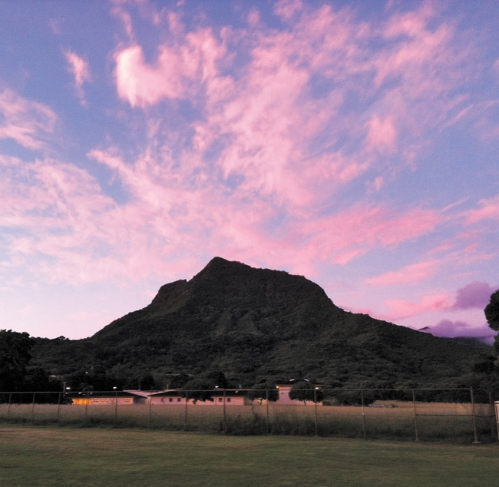Clearing The Way For A Rare View
Every cloud may have a silver lining, but so do cloudless days, particularly when the trade winds are light or nonexistent.
The silver lining was recently quite golden when a high-pressure system to the north of our island chain was pushed aside and our trade winds were turned off for a few days.
The result was phenomenal visibility across the state. Scenic lookouts and beaches on Oahu’s southeastern coastline were packed with people as visitors and residents marveled at the sight of not only Molokai and Maui on the horizon, but also Mauna Loa and Mauna Kea on the island of Hawaii, more than 200 miles away!
“The key for experiencing such great visibility is truly all about air quality,” says Mike Cantin, warning coordination meteorologist at the National Weather Service. “Most trade-wind days, the air around the Islands is filled with suspended water droplets and sea spray produced by the consistent wind and churning easterly swells. These suspended particles reflect, absorb and refract light, which makes it difficult to see beyond them, especially in higher concentrations.”
That was clearly not the case over the Fourth of July holiday weekend. From Diamond Head to Sandy Beach, folks lined the shoreline to get a rare glimpse of a large portion of our Hawaiian Island chain. Cantin says there’s a scientific reason for what many of us saw and why it only got better as the day progressed.
“Since the angle between Diamond Head and the Big Island is basically along the curvature of the Earth, the viewing area is just above ocean level,” he explains. “Normal concentrations of suspended particles above the ocean surface will easily blot out extended views. In general, the higher the sun, the better the view would be, because the sunlight is passing through less of the suspended particles between you and the view when it approaches them vertically, rather than horizontally.”
Cantin goes on to explain that when our trade winds are light to nonexistent, there is far less of these suspended particles and the atmosphere essentially settles. However, if winds are too strong out of the south, visibility often is extremely poor.
“If the Kona winds are too strong, vog (volcanic air pollution from Kilauea volcano) will likely be drawn to the north over portions of the state, which substantially reduces visibility and air quality because of the copious amount of suspended particles in the atmosphere,” says Cantin. “So when the winds are light across the state there are far fewer suspended particles in the atmosphere, including sea spray, salt, water droplets and volcanic haze, which allows for clearer visibility.”
The light trades also helped put on quite a show during sunrises and sunsets. Cantin says the scientific explanation to the incredibly colorful mornings and afternoons is similar to why visibility was so great.
“When it comes to sunrises and sunsets, the lack of suspended particles allows more sunlight to reach nearby clouds to generate spectacular displays,” he says. “Having some cloud cover is an important part of the ‘perfect sunset’ equation. Clouds in the mid-level of the atmosphere 12,000 to 20,000 feet seem to be the best, as they form the right angle to catch the fading sunlight. Many times it’s altostratus (clouds) that really light up.”
Cantin is not only a meteorologist; he’s also a dad and, like many of us, he too saw the impact the light trades were having on his own children.
“The sunset was truly spectacular, and I got some nice pictures from Waianae,” says Cantin. “Even my kiddos stopped what they were doing and watched for awhile. Trust me, that’s impressive!”






